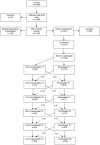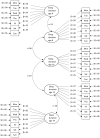Persistent Short Sleep from Childhood to Adolescence: Child, Parent and Peer Predictors
- PMID: 33623458
- PMCID: PMC7894796
- DOI: 10.2147/NSS.S290586
Persistent Short Sleep from Childhood to Adolescence: Child, Parent and Peer Predictors
Abstract
Purpose: Many children have periods when they sleep too little, with widely recognized detrimental effects. Less is known about persistent short sleep during childhood. Therefore, the present study aimed to investigate the prevalence of persistent short sleep in school-aged children and identify a set of child, parent, and peer predictors thereof.
Participants and methods: Objectively measured sleep duration (hip-held accelerometer) was biennially assessed in a community sample followed from 6 to 14 years (n=801). A latent profile analysis was applied to assess whether a subgroup of children slept consistently short across time and predictors of persistent short sleep were determined through regression analysis.
Results: A subgroup of children (n=160; 20.2%) was identified as having persistent short sleep across time. Temperamental negative affectivity (β=0.08; 95% CI=0.01, 0.15; p=0.03) and low observer-assessed parental emotional availability (β=-.09; 95% CI=-.18, -.01; p=0.04) predicted membership to that group. Teacher ratings of victimization from bullying were not associated with persistent short sleep (β=0.01; 95% CI: -.10, 11; p=0.88).
Conclusion: High child temperamental negative affectivity and low parental emotional availability may be involved in the development of persistent short sleep through childhood.
Keywords: actigraphy; childhood; early adolescence; insufficient sleep; negative affectivity; parental emotional availability; prospective cohort study; sleep duration; victimization from bullying.
© 2021 Ranum et al.
Conflict of interest statement
The authors report no conflicts of interest in this work.
Figures
Similar articles
-
Peer Victimization and Academic Performance in Primary School Children.Acad Pediatr. 2017 Nov-Dec;17(8):830-836. doi: 10.1016/j.acap.2017.06.012. Epub 2017 Jun 23. Acad Pediatr. 2017. PMID: 28652070
-
Revealing the Transactional Associations among Teacher-Child Relationships, Peer Rejection and Peer Victimization in Early Adolescence.J Youth Adolesc. 2020 Nov;49(11):2311-2326. doi: 10.1007/s10964-020-01269-z. Epub 2020 Jun 15. J Youth Adolesc. 2020. PMID: 32556838
-
Prevalence and stability of insufficient sleep measured by actigraphy: a prospective community study.Pediatr Res. 2020 Jul;88(1):110-116. doi: 10.1038/s41390-020-0768-y. Epub 2020 Jan 31. Pediatr Res. 2020. PMID: 32005964 Free PMC article.
-
Parenting behavior and the risk of becoming a victim and a bully/victim: a meta-analysis study.Child Abuse Negl. 2013 Dec;37(12):1091-108. doi: 10.1016/j.chiabu.2013.03.001. Epub 2013 Apr 25. Child Abuse Negl. 2013. PMID: 23623619
-
Long-term adult outcomes of peer victimization in childhood and adolescence: Pathways to adjustment and maladjustment.Am Psychol. 2015 May-Jun;70(4):300-10. doi: 10.1037/a0039174. Am Psychol. 2015. PMID: 25961311 Review.
Cited by
-
The relationship between adolescent sleep duration and exposure to school bullying: the masking effect of depressive symptoms.Front Psychol. 2024 Dec 16;15:1417960. doi: 10.3389/fpsyg.2024.1417960. eCollection 2024. Front Psychol. 2024. PMID: 39737241 Free PMC article.
-
Waking up to sleep's role in obesity and blood pressure among Black adolescent girls in low-income, US urban communities: A longitudinal analysis.Sleep Health. 2022 Apr;8(2):200-207. doi: 10.1016/j.sleh.2021.12.001. Epub 2022 Feb 11. Sleep Health. 2022. PMID: 35153168 Free PMC article. Clinical Trial.
References
LinkOut - more resources
Full Text Sources
Other Literature Sources




